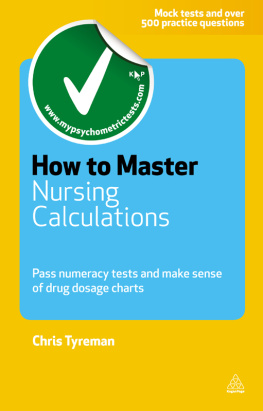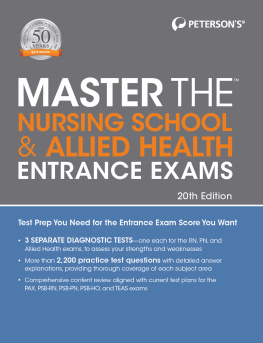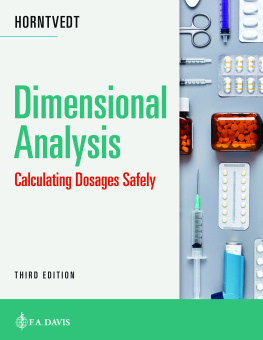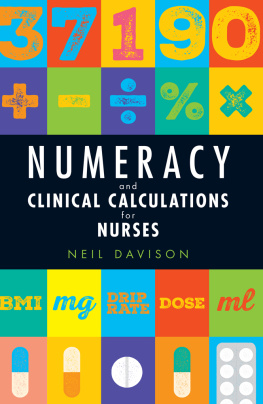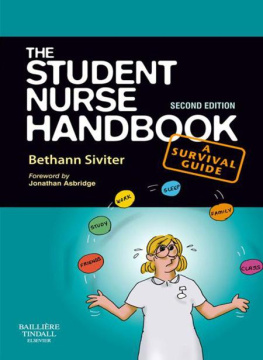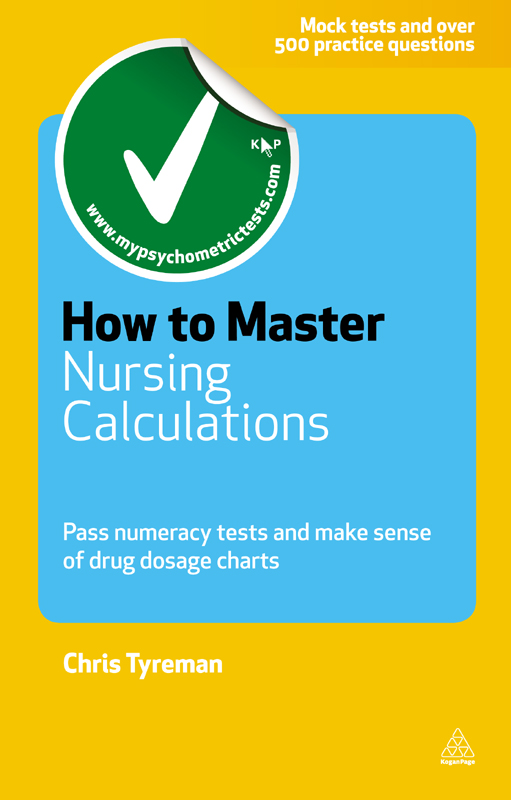While the author has made every effort to ensure that the content of this book is accurate, please note that occasional errors can occur in books of this kind. If you suspect that an error has been made in any of the tests included in this book, please inform the publisher at the address below so that it can be corrected at the next reprint.
The drug names, dosages, administration routes and schedules described in this book are intended for training purposes only. It is the individual practitioners responsibility to consult the manufacturers product information and the current British National Formulary before selecting treatments. Neither the author nor the publisher can assume any liability for any injury and/or damage to persons or property arising from the information contained in this book.
Publishers note
Every possible effort has been made to ensure that the information contained in this book is accurate at the time of going to press, and the publishers and author cannot accept responsibility for any errors or omissions, however caused. No responsibility for loss or damage occasioned to any person acting, or refraining from action, as a result of the material in this publication can be accepted by the editor, the publisher or the author.
First published in Great Britain in 2008 by Kogan Page Limited
Reissued 2010
Apart from any fair dealing for the purposes of research or private study, or criticism or review, as permitted under the Copyright, Designs and Patents Act 1988, this publication may only be reproduced, stored or transmitted, in any form or by any means, with the prior permission in writing of the publishers, or in the case of reprographic reproduction in accordance with the terms and licences issued by the CLA. Enquiries concerning reproduction outside these terms should be sent to the publishers at the undermentioned addresses:
Kogan Page Limited
120 Pentonville Road
London N1 9JN
United Kingdom
www.koganpage.com
Chris Tyreman, 2008, 2010
The right of Chris Tyreman to be identified as the author of this work has been asserted by him in accordance with the Copyright, Designs and Patents Act 1988.
British Library Cataloguing-in-Publication Data
A CIP record for this book is available from the British Library.
ISBN 978 0 7494 6155 3
E-ISBN 978 0 7494 6156 0
Typeset and eBook by Graphicraft Limited, Hong Kong
Printed and bound in India by Replika Press Pvt Ltd
Unless you try to do something beyond what you have already mastered, you will never grow.
RALPH WALDO EMERSON 18031882
Contents
M ost medications are administered by nurses. Consequently it is nurses who are responsible for most of the errors made in drug administration. One source of mistakes is a lack of competence in drug dosage calculations. To promote safe practice, nursing schools can test for poor basic arithmetic skills both at the interview stage and during the three years of nurse training. This book teaches the skills necessary for success in these tests. It also explains how to read the drug treatment sheets used in the administration of medicines.
The mathematics knowledge required either at the interview stage or at nursing school does not exceed GCSE standard. You need only the four arithmetic skills of addition (+), subtraction (), multiplication () and division () as applied to whole numbers, fractions and decimal numbers. Knowledge of drug administration is not required for interview-type questions. Tests for student nurses may include medical terms and abbreviations, many of which are obvious, although a few Latin ones need to be remembered. This book does not cover all of the ones you will come across in nursing, only those that you are likely to meet in maths exams.
The book caters for most levels of mathematical ability, so it is suitable for mature students who have had little experience of numerical work since leaving school. Even candidates with very poor numerical skills should find it helpful.
Calculators are not allowed in the examination room, so it is vital that you can understand basic arithmetic processes and solve problems in you head using mental arithmetic or by writing the calculation down on paper.
The first two chapters will familiarize you with the key topics of arithmetic, fractions, decimals and percentages. covers drug dosage calculations, starting with simple problems that require only one or two arithmetic steps before moving on to more complicated calculations that require several arithmetic steps.
covers drug names and drug dosage charts, or treatment sheets as they are known. It tests your ability to dispense the right drug in the right amount to the right patient via the right route at the right time the five Rs of drug administration. It is not intended to test your knowledge of drugs, only your ability to read charts and carry out simple mathematical calculations. In practice you will need to reflect on normal doses, the purpose of the medication (its indication), unwanted side-effects and adverse reactions. These skills are essential for the safe administration of medications but are not part of this book.
The student is advised to work systematically through the book from start to finish, completing the in-text questions. The answers are to be found at the end of the book. If any chapter is too simple or does not meet your learning needs, then skip to the questions at the end of the chapter. If you can answer all of the questions correctly, you already have the essential knowledge and can move on to the next chapter.
The final chapter of the book contains practice questions of the type normally found in nursing school maths tests. A basic numerical test is followed by three nursing calculation mock tests of 50 questions each. You have one hour to complete each of the mock tests and the pass mark is 40 correct answers (80 per cent). Pass marks in nursing school tests are normally set high. Errors in drug administration are unacceptable and always require further investigation. When you are out on the wards the pass mark is 100 per cent!
Basic maths self-assessment test
Student nurses come from very varied backgrounds and have different employment and education experiences. The following test is aimed at students making a fresh start in education. It will reveal any gaps in your mathematical knowledge. There are three levels of difficulty: remedial, level 1 and level 2, with 10 questions at each level. If you make any mistakes at the remedial level, you may have a special needs problem that is beyond the scope of this book. However, you should study the first eight pages of and attempt the first two exercises before seeking help.
University students should be able to answer all of the questions at level 1 correctly. Wrong answers at this stage can be rectified by studying the first three chapters. Success at level 2 requires a firm foundation in numeracy. Mistakes made at this level will help you to identify those topics that need particular attention: for example, fractions, decimals, percentages or the metric system. Competency in these skills is essential for drug dosage calculations.
The test has no time limit nor does it require any knowledge of drug administration; calculators are not allowed. Answers can be found at the end of the book. There is no pass mark but you can check your results against the following guide to numerical competency:

